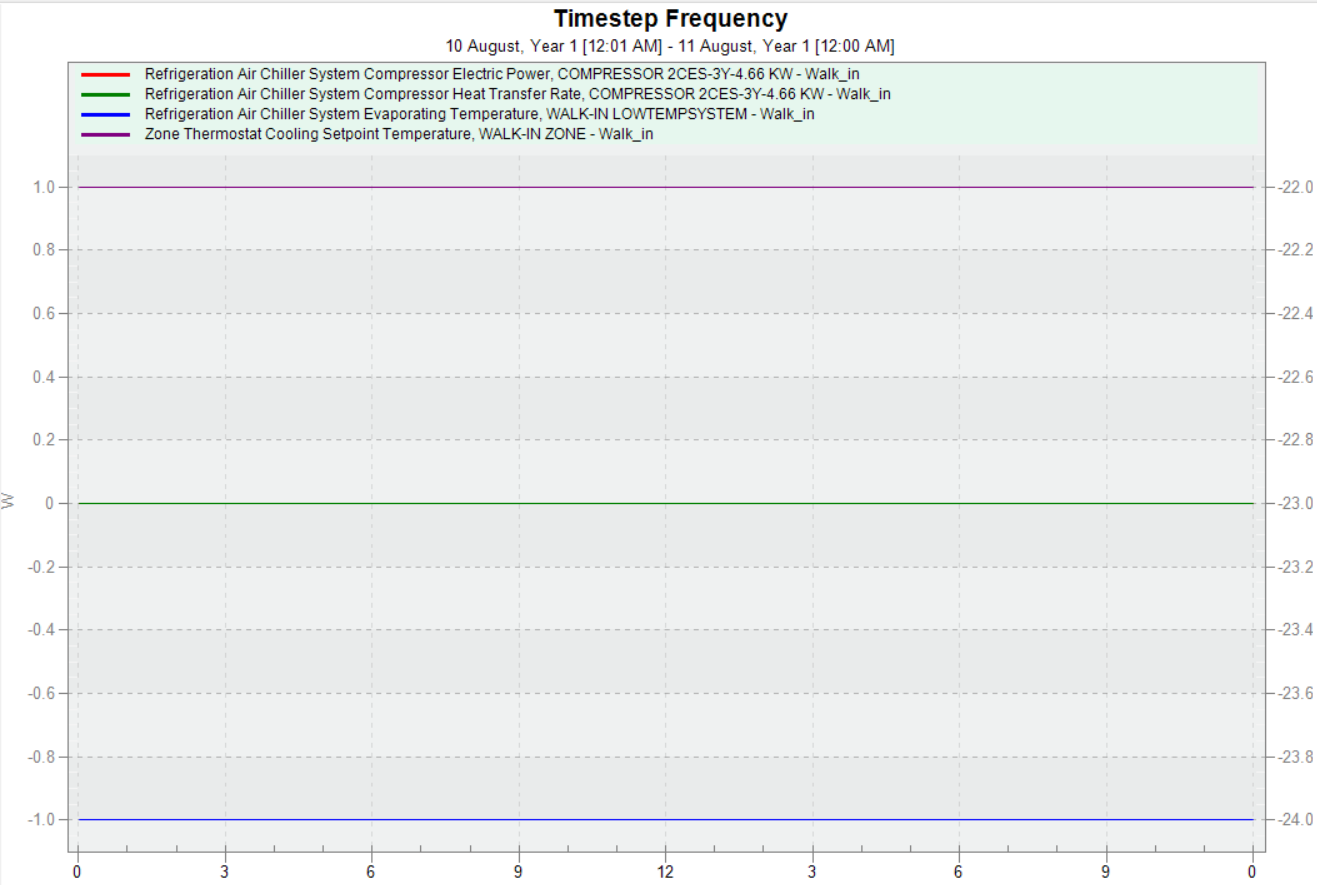First time here? Check out the Help page!
 | 1 | initial version |
I believe the output for the Refrigeration Air Chiller System Evaporating Temperature remains constant, corresponding to the Rated Cooling Source Temperature input for the air chiller. This conclusion is based on a simulation where the air chiller was inactive for 24 hours, and the Refrigeration Air Chiller System Evaporating Temperature consistently matched the -24°C value of the Rated Cooling Source Temperature.
In the provided figure, the compressor's electric power and heat transfer rate, plotted on the left, both register as zero since the refrigeration system is turned off. Nevertheless, the evaporating temperature persists at -24°C, precisely matching the Air Chiller's Rated Cooling Source Temperature.
Based on these observations, it seems plausible that E+ does not independently calculate the evaporating temperature; rather, it appears to directly pass the Rated Cooling Source Temperature input as an output.
I would appreciate confirmation or additional insights from anyone familiar with this.

 | 2 | No.2 Revision |
I believe the output for the Refrigeration Air Chiller System Evaporating Temperature remains constant, corresponding to the Rated Cooling Source Temperature input for the air chiller. This conclusion is based on a simulation where the air chiller was inactive for 24 hours, and the Refrigeration Air Chiller System Evaporating Temperature consistently matched the -24°C value of the Rated Cooling Source Temperature.
In the provided figure, the compressor's electric power and heat transfer rate, plotted on the left, both register as equil zero since the refrigeration system is turned off. Nevertheless, the evaporating temperature persists at -24°C, -24°C ( on the right), precisely matching the Air Chiller's Rated Cooling Source Temperature.
Based on these observations, it seems plausible that E+ does not independently calculate the evaporating temperature; rather, it appears to directly pass the Rated Cooling Source Temperature input as an output.
I would appreciate confirmation or additional insights from anyone familiar with this.

 | 3 | No.3 Revision |
I believe the output for the Refrigeration Air Chiller System Evaporating Temperature remains constant, corresponding to the Rated Cooling Source Temperature input for the air chiller. This conclusion is based on a simulation where the air chiller was inactive for 24 hours, OFF during the simulation runtime, and the Refrigeration Air Chiller System Evaporating Temperature consistently matched the -24°C value of the Rated Cooling Source Temperature.
In the provided figure, the compressor's electric power and heat transfer rate, plotted on the left, both equil zero since the refrigeration system is turned off. Nevertheless, the evaporating temperature persists at -24°C ( on the right), precisely matching the Air Chiller's Rated Cooling Source Temperature.
Based on these observations, it seems that E+ does not independently calculate the evaporating temperature; rather, it appears to directly pass the Rated Cooling Source Temperature input as an output.
I would appreciate confirmation or additional insights from anyone familiar with this.

 | 4 | No.4 Revision |
I believe the output for the Refrigeration Air Chiller System Evaporating Temperature remains constant, corresponding to the Rated Cooling Source Temperature input for the air chiller. This conclusion is based on a simulation where the air chiller was OFF during the simulation runtime, and the Refrigeration Air Chiller System Evaporating Temperature consistently matched the -24°C value of which is exactly the Rated Cooling Source Temperature.
In the provided figure, the compressor's electric power and heat transfer rate, plotted on the left, both equil zero since the refrigeration system is turned off. Nevertheless, the evaporating temperature persists at -24°C ( on the right), precisely matching the Air Chiller's Rated Cooling Source Temperature.
Based on these observations, it seems that E+ does not independently calculate the evaporating temperature; rather, it appears to directly pass the Rated Cooling Source Temperature input as an output.
I would appreciate confirmation or additional insights from anyone familiar with this.

